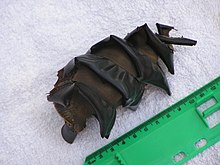Port Jackson Bullhead Shark
| Port Jackson Bullhead Shark | ||||||||||||
|---|---|---|---|---|---|---|---|---|---|---|---|---|

Port Jackson bullhead shark ( Heterodontus portusjacksoni ) |
||||||||||||
| Systematics | ||||||||||||
|
||||||||||||
| Scientific name | ||||||||||||
| Heterodontus portusjacksoni | ||||||||||||
| ( Meyer , 1793) |
The Port Jackson bull head shark ( Heterodontus portusjacksoni ) is a 1 to 1.2 m (max. 1.65 m) long, gray to light brown shark with some noticeable dark stripes. It occurs only off Australia and New Zealand and is known for bite accidents with bathers because it often defends itself in the event of disturbances. It often rests on the bottom, even in shallow stretches of water. Otherwise it is completely harmless to humans.
Appearance and characteristics
The Port Jackson bull head shark has an average body length of 100 to 120 cm and can reach a maximum size of 160 cm. It has a light brown to gray, in rare cases almost white body color with a conspicuous drawing of dark vertical stripes on the head and cheeks. Behind the gills, the strips form a triangle, the corners of which extend from the first dorsal fin, the pelvic fins and the pectoral fins. There is also a black stripe across the flanks and tail.
The shark has a cylindrical body with a conical head. The snout is very small and broadly rounded, the eye bulges are low. It has an anal fin and two dorsal fins , both of which are thorny. The first dorsal fin begins above the base of the pectoral fins, the second dorsal fin above the ends of the pelvic fins. The shark has five comparatively long gill slits and a very small injection hole (spiraculum) below the eye.
Way of life
The Port Jackson bullhead shark is a nocturnal species and lives near the coast (intertidal zone) in the area of the continental shelf and on island bases to depths of around 170 m. It lives in caves and on sandy bottoms as well as in shallow reefs, where it aggregates into groups of up to 16 animals. An Australian study showed that the sharks in these clusters not only know each other, but also specifically seek the company of certain individuals over many years. National Geographic then headlined: "Sharks have best friends, like us." (Sharks have best friends, just like us.)
It feeds mainly on echinoderms such as starfish and sea urchins , but also hunts other invertebrates ( shrimp , lobsters , crabs , lobsters , clams , snails , octopuses ) and small fish.
Like all bull head sharks, it is oviparous and lays relatively simple eggs. These have two flat combs that run helically around the shell axis and short horn threads at the ends of the egg shell. The females lay 10 to 16 eggs seasonally under stony shelters in flat reefs. The young sharks hatch after 9 to 12 months with a size of around 23 cm, after which they migrate to estuaries and shallow bays to protect them from larger predators . The animals reach sexual maturity at a length of about 50 to 80 cm.
distribution
The Port Jackson bullhead shark is distributed in the western South Pacific almost in the entire coastal area of Australia from southern Queensland via New South Wales , Victoria , Tasmania as well as southern and western Australia and around New Zealand .
literature
- Leonard Compagno , Marc Dando, Sarah Fowler: Sharks of the World . Princeton University Press , Princeton and Oxford 2005, ISBN 978-0-691-12072-0 , pp. 152-153.
Web links
- Port Jackson Bullhead Shark on Fishbase.org (English)
- Entry in the database of the Shark Foundation
- Heterodontus portusjacksoni inthe IUCN 2013 Red List of Threatened Species . Posted by: Simpfendorfer, C., 2005. Retrieved November 5, 2013.



